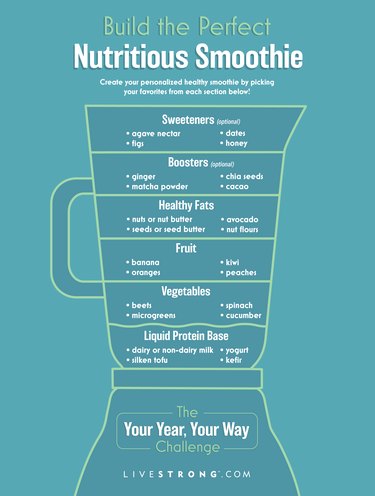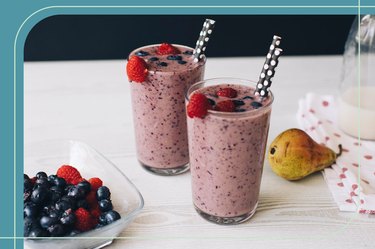

Judging by social media, you'd think green smoothies were the pinnacle of wellness. But there's good news for anyone who isn't a huge fan of spinach-spirulina-chia blends: You can make healthy smoothies using ingredients you actually like.
Ditch kale or protein powder or even bananas if you don't enjoy them; there are countless other smoothie combinations to pack in produce along with protein and healthy fats. Balancing those macros is the most important part of smoothie prep, according to Maya Feller, RD, CDN, owner of Brooklyn-based Maya Feller Nutrition. That way, you have a nourishing, standalone snack, dessert or breakfast to enjoy.
Video of the Day
Video of the Day
To make sure you always achieve that balance, there are a few basic guidelines for smoothie greatness:
- Always include a vegetable for maximum nutrition.
- Add fruit for a touch of sweetness.
- Include lean (usually liquid) protein to keep you feeling full.
- Toss in healthy fats for texture and satisfaction.

Step 1: Start With a Liquid Protein Base
The main protein source in smoothies is often a liquid, which is also your base. The amount of liquid you use will help determine how thick your smoothie will be. It also provides protein to help keep you full and satisfied.
A good rule of thumb for the list below is the thicker the ingredient, the higher the protein. For example, 1 cup of unsweetened almond milk contains 1 gram of protein while 1 cup of low-fat cow's milk has 8 grams of protein, according to the USDA. If you're using a plant-based milk as your base, you may want to choose additional boosters (more on those below) to up the total protein in your smoothie.
"You'll have a lot of natural sugars with the fruit, [so] consider what liquid base you're using," Feller says. If you're going heavy on the fruits, balance it out with lower-sugar bases like plain Greek yogurt or an unsweetened milk alternative, she says.
Choose one of the liquid bases below:
- Unflavored plant-based milk (almond, hemp, oat, etc.)
- Low-fat cow's milk
- Low-fat or fat-free plain kefir
- Low-fat fat-free plain yogurt
- Low-fat or fat-free plain Greek yogurt
- Silken tofu
Tip
To avoid splashes every time you plop a solid ingredient into your blender, pour your liquid in last.
Step 2: Add Vegetables
Most people fall short on their daily veggie intake, so smoothies are an easy (and tasty) way to sneak in some non-starchy vegetables and leafy greens. Aim for at least one vegetable in your smoothie, but keep in mind a mix delivers a wider variety of nutrients.
If you want to add leafy greens but find that kale or arugula overpowers the rest of your smoothie, choose spinach or Swiss chard instead. Both offer similar health benefits but are neutral in flavor.
Toss in 1 to 2 cups of any of the following:
- Kale
- Spinach
- Arugula
- Swiss chard
- Beet greens
- Cucumber
- Celery
- Micro greens
- Summer squash
- Carrots
- Beets
- Pumpkin puree
Step 3: Pick Your Fruit
Not sold on veggies? "Fruits are fantastic, too," Feller says. "But [because] smoothies are a liquid carbohydrate, it's important to be mindful of the quantity or the portion size and to make an intentional choice."
The fruits you use play a major role in the flavor of your smoothie. Fresh fruit is always a great choice. However, going frozen is an easy way to add instant thickness to your smoothie.
Choose 1/2 to 1 cup of any of the following:
- Bananas
- Berries
- Cherries (remove the pits first)
- Blueberries
- Oranges
- Mango
- Pineapple
- Peaches
- Apples
- Pomegranate
- Kiwi
- Watermelon
Tip
You can also take your farmers' market haul, lay it on sheet pans, then freeze and place in resealable freezer bags to use in your smoothies later. And next time you have a bunch of bananas heading toward overripe, peel and slice them, toss them in a resealable freezer bag and freeze for future smoothies.
Step 4: Blend in Healthy Fats
Plant-based items like nuts or nut butter and seeds or seed butter add healthy fats to your smoothie, rounding it out for a well-balanced snack or meal. These ingredients also help thicken your smoothie for a creamier consistency.
Feller likes to mix in nut flours, such as almond or hazelnut flour. Nut flours integrate easily, helping create a creamy texture, she says.
Aim for 1 to 2 tablespoons of any of the following:
- Nuts or nut butter
- Seeds or seed butter
- Nut flours
- 1/4 of an avocado
Optional: Add a Booster
Boosters like the ones below can offer extra nutrition and flavor and keep your smoothie routine from feeling stale. Feller loves powders as boosters and alternates between a few different options, including chlorella, spirulina (both types of algae) and beet powder.
Use 1 to 3 teaspoons of:
- Chia seeds
- Protein powder
- Rolled oats
- Cacao
- Goji berries
- Spirulina
- Ginger
- Matcha powder
- Coconut water
- Brewed tea or coffee
- Vegetable juice
Optional: Stir in a Sweetener
Additional sweeteners are optional, as fruit often provides plenty of sweetness. But if you need a little extra to balance out some of the bitterness from leafy greens or to curb your sweet tooth, try 1 teaspoon of any of the following:
- Honey
- Maple syrup
- Agave nectar
- Stevia
- 1 date
- 1 fig
Put It All Together in These Recipes
